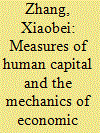| Srl | Item |
| 1 |
ID:
087970


|
|
|
| 2 |
ID:
024074


|
|
|
|
|
| Publication |
New York, Harper and Row, Publishers, 1972.
|
| Description |
x, 292p.Hbk
|
| Standard Number |
060416416
|
|
|
|
|
|
|
|
|
|
|
|
Copies: C:1/I:0,R:0,Q:0
Circulation
| Accession# | Call# | Current Location | Status | Policy | Location |
| 011090 | 910.133/LLO 011090 | Main | On Shelf | General | |
|
|
|
|
| 3 |
ID:
182763


|
|
|
|
|
| Summary/Abstract |
We examine the mechanism by which human capital affects economic growth and convergence, using provincial level panel data from China. We specify alternative measures of human capital and apply them to an enhanced growth model, which we estimate parametrically, nonparametrically, and with a threshold model. Our results show that economic convergence is pronouncedly conditional on human capital across all measures. The positive “benefit of being backward” due to lower initial income is almost trumped by the negative impact of low levels of human capital in the poorest areas.
|
|
|
|
|
|
|
|
|
|
|
|
|
|
|
|
| 4 |
ID:
139546


|
|
|
|
|
| Summary/Abstract |
This study estimates the extent of subsidization in the ten provinces of western China from 1990 to 2012 with the aim of highlighting the exceptionality of the Tibet Autonomous Region (TAR) leading up to and following the widespread Tibetan protests that swept through four Chinese provinces in 2008. Although the Tibet development model was criticized by many Chinese economists in the 1980s and 1990s for being highly subsidy-dependent and inefficient, these aspects of dependence and inefficiency were exacerbated even further under the Hu–Wen administration, particularly following the 2008 protests. While subsidies and investment also increased in other western provinces, the exceptionality of the TAR stands out in terms of the levels of subsidization attained, the sheer disassociation of these subsidies from changes in the local productive economy, and the degree to which ownership in the local economy has come to be dominated by external interests. The recent phase of intensive subsidization has thereby exacerbated the dependence of local Tibetan livelihoods on these state strategies, while at the same time intensified the state-led economic integration of the region into the rest of China through externalized patterns of ownership and consolidated state control. Arguments that the resultant inefficiencies and social tensions are owing to a marketization of social relations or to cultural insensitivity and lack of adaptation to local circumstances de-emphasize the central role of the state in shaping the deeply structural character of these transformations.
|
|
|
|
|
|
|
|
|
|
|
|
|
|
|
|
| 5 |
ID:
123200


|
|
|